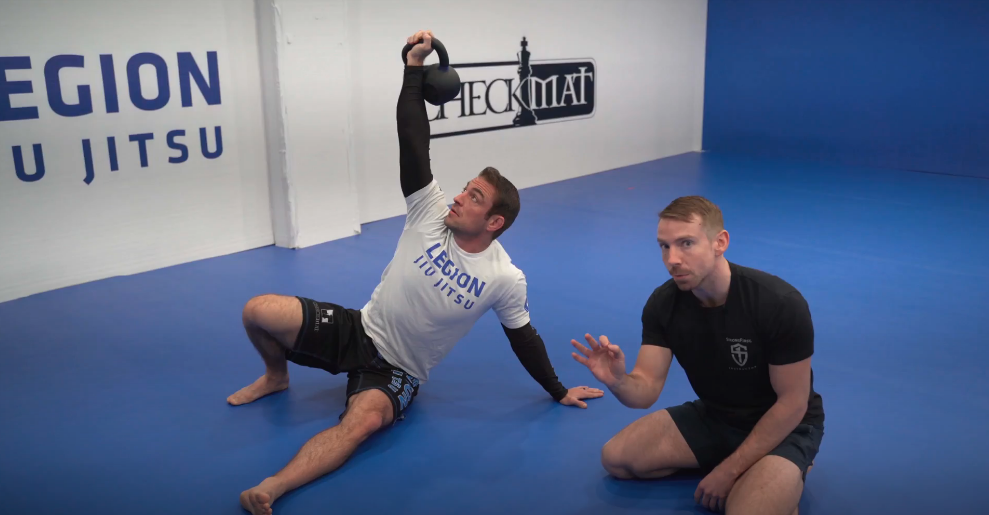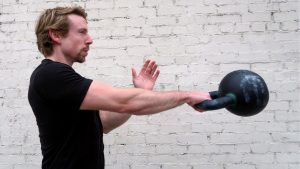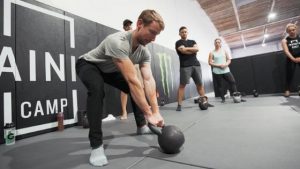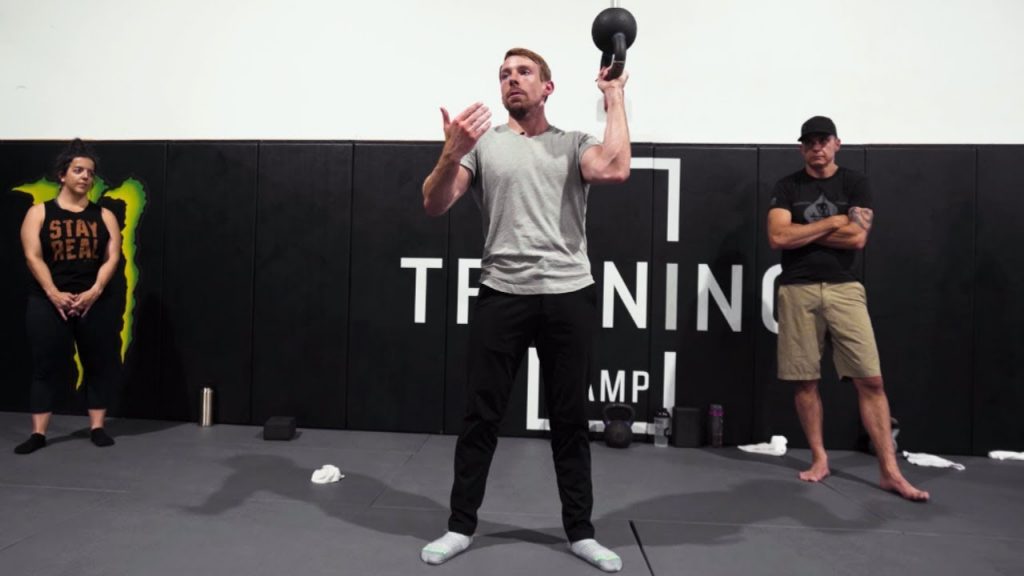
Wrestling was the one sport I showed any aptitude for as a kid.
I just didn’t have the discipline reserves to handle the long practices AND get my homework done. Yes, I was, and still am, way more nerd than jock.
The more I got into training and teaching kettlebells, the more I noticed my peers were involved in martial arts and specifically Brazilian Jiu-Jitsu.
Learning new skills is fun and important for personal development, but keeping a student’s mind is absolutely key for being an effective coach.
So it was that with a wild hair and some encouragement, I joined Legion BJJ in East Nashville.
My belt is still as white as my winter thighs, but I’ve already gained a mountain of perspective about the body that now impacts how I train and coach.
I was stoked when Professor Sean Patton asked me to help out with his kettlebell programming and to contribute to the team’s Youtube channel.
With that, here’s my hot take on the top kettlebell exercises for BJJ.
The Swing Is The Key To High-Performance Hips
Training the standard 2-hand kettlebell swing is a must for BJJ athletes. Here’s why:
The KB swing builds strength, power, and even flexibility in the hips.
That power is expressed through the hip hinge – simply the movement of the hips back (flexion) and aggressively forward (extension). Think about the mechanics of a bow and arrow and you’re on the right track.
When you learn how to hip hinge just right for your body, you’ll not only unlock more power, but also spare your back from unnecessary strain as well.
Every movement pattern gives us a unique weapon to use in our jiu jitsu. In this light, the hip hinge is the body’s “cannon.” And after all, the kettlebell is just a cannonball with a handle.
All else equal, you can create the most force against your opponent with the hips.
Learn the hip hinge. Power the hip hinge. The kettlebell swing is your ticket.
Boost BJJ Core Strength With The Single-Arm Kettlebell Swing
Nothing in jiu-jitsu is static or symmetrical. You must be prepared to “multitask” with your body – stable here, mobile there.
We can fortify ourselves against the randomness of rolling with asymmetrical training – simply using one side of the body differently than the other.
For the swing, we’ll just remove one arm from the kettlebell.
The basic technique remains unchanged, but the one-arm kettlebell swing will present an extra challenge to the core, grip, and upper body stability.
Some tips:
- Stay “rooted” through the feet. Maintain tripod balance for the entire set and resist popping back on the heels.
- Keep your hips and shoulders square.
- Engage the lat and pec on the loaded side to create a stable shoulder.
- Don’t over-tense the arm and grip.
- Use your free arm to actively guide the swing. Don’t let it flop around.
Use This Kettlebell Swing For Even More Explosive Hip Power
“I fear not the man who has practiced 10,000 kicks once, but I fear the man who has practiced one kick 10,000 times.” — Bruce Lee
Most kettlebell swing workouts aim to stack up the daily volume, sometimes with multiple hundreds of reps. And it’s great to build your skill and work capacity up to that point.
But what if we go in the opposite direction and do as few reps as possible?
That’s where Power (or Dead-Stop) swings come in. Instead of swinging a kettlebell for multiple reps at a time, we perform the swing in singles.
The kettlebell is returned to the floor between every rep, eliminating all momentum and any boost from the stretch reflex.
This is exactly how powerlifters train “off the floor” strength with the barbell deadlift.
Generating tension, strength, and power from a dead stop is a unique and valuable physical skill… plus, it’s exhausting.
The Best Kettlebell Press For Resilient Shoulders
The secret to strong shoulders? The interplay of mobility and stability.
You’ll need plenty of both to stay healthy.
Shoulder pain is common enough in the general fitness population, but add the stresses of BJJ in the mix, and smart shoulder training becomes a non-negotiable.
Typical shoulder routines, and the way they are performed, do little to improve the the way the joint actually moves and functions. Your shoulders take a beating on the mat and most upper body workouts just add insult to injury.
There is a simple way you can hold the kettlebell that will automatically stabilize your shoulder, effectively engage the rotator cuffs, and prevent you from moving into dangerous ranges of motion.
Just grip it upside-down. Or in kettle lingo – bottoms-up.
With the BU technique, the bell is balanced above the hand. This requires the coordination of grip strength, elbow and forearm position, rotator cuff activation, and stability from the entire body (lats, core, hips, legs, feet).
If any of these points are compromised, the kettlebell will wiggle around in your hand. If you try to push beyond your ability, the kettlebell will fall. This is what’s known as a self-limiting exercise.
As demonstrated in the video, just holding the bell in the bottoms-up position is the first step. Once you are comfortable with the position, add the press movement as far as you can control (half-presses are totally fine).
The Turkish Get-Up: “Like yoga. With Weight.”
Focus under pressure is a must for the combat athlete.
The Turkish get-up delivers in spades with a sequence that takes you from lying to standing and back down, all while developing strength, mobility, and total-body coordination.
The story goes that Turkish wrestlers in the days of yore were tasked with standing up from the ground under a 100 pound stone as part of their training.
Today, the TGU offers an entire toolbox of drills, patterns, and exercises to increase resilience and athleticism for any trainee.
Programming Principles for BJJ
Now that we have the techniques, how do we program kettlebell workouts for BJJ?
First, let’s establish a few guiding principles for effective training.
- Training should fill gaps
- What do you need to work on? Work on it!
- Training should enhance strengths
- You’re strong. How could you get stronger?
- Every exercise has a risk/reward ratio
- Weigh the costs and benefits. What makes for a wise investment vs. a waste of time?
- Respect recovery
- You can do anything, but not everything.
Let’s write out a sample program for a BJJ athlete who wants to maintain a 5x/week training schedule.
Monday – BJJ class
Tuesday – Rest
Wednesday – Cardio + mobility and light BJJ class
Example —> Block #1 – Every Minute On The Minute x 10-15 minutes – 15-20 swings on even minute / 10 goblet squats on odd minute.
Block #2 – Slow TGU x 1-3 each side. Stretch, joint circles, bar hangs, ab work.
Thursday – BJJ class
Friday – Work capacity session
Example —> Block #1 – 5 Power swings into 10/10 1-H Swings into 15 push-ups. Rest 60-90 seconds and repeat for 6-8 rounds.
Block #2 – 100 2-H Swings for time then 30s jump rope / 30s farmer carry x 5 minutes.
Saturday – Strength session
Example —> Block #1 – Pull-up x 2, 4, 6, 8, 6, 4, 2 / bottoms-up press x 2 each side between each set
Block #2 – 5×5 Deadlift (60-80%) / Hanging leg raise or ab wheel
Sunday – Rest
Bonus Tips!
Release Tight Hips and Unlock Your Athletic Power
[Now Available] The Hybrid Hip Mobility Video
You may also like these latest posts:
Kettlebells for Crossfit Coaches (Workshop Video)
2 Crazy Partner Kettlebell Workouts
[Free] 21-Day Kettlebell Core Challenge Program
For more training ideas, be sure to follow me on Instagram


